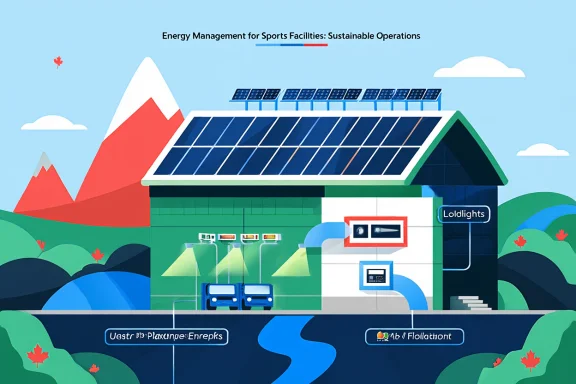Energy Management for Sports Facilities: Sustainable Operations

The Energy Challenge Facing Canadian Sports Facilities
Canadian sports facilities face a unique challenge that would make even the toughest hockey player sweat — soaring energy costs combined with extreme weather conditions from coast to coast to coast. With electricity rates varying dramatically across provinces (from Quebec’s hydro advantage to Ontario’s peak pricing), facility managers are looking for smart ways to cut costs without compromising the quality of their sports programs.
The average community centre in Canada spends between 30-40% of its operating budget on energy costs. That’s a hefty chunk of change that could be better invested in new equipment, facility improvements, or program expansion. The good news? Smart energy management through strategic scheduling can slash these costs by up to 30% while supporting Canada’s commitment to reducing greenhouse gas emissions.
Why Smart Scheduling is Your Energy Management MVP
Understanding Peak Demand Charges
Most Canadian provinces use time-of-use billing, where electricity costs more during peak hours (typically 7-11 AM and 5-9 PM on weekdays). For sports facilities, this creates both challenges and opportunities.
Peak Hour Realities:
- Ontario facilities can pay 3x more during peak hours
- Alberta’s deregulated market creates price volatility
- British Columbia’s stepped rate structure rewards conservation
Smart scheduling means shifting non-essential activities to off-peak hours. Instead of running ice resurfacing during expensive evening hours, savvy facilities schedule maintenance during mid-afternoon lulls when rates are lower.
The Domino Effect of Equipment Optimization
When you coordinate your facility’s systems, the energy savings multiply like goals in a Gretzky highlight reel. Here’s how it works:
Lighting Systems:
- LED retrofits reduce consumption by 60-80%
- Motion sensors eliminate waste in unused areas
- Daylight harvesting maximizes natural light during shoulder seasons
HVAC Coordination:
- Pre-cooling facilities during off-peak hours
- Adjusting temperatures based on occupancy schedules
- Using thermal mass to maintain comfort during peak rate periods
Practical Energy Management Strategies
Seasonal Scheduling Optimization
Canada’s dramatic seasonal changes offer unique opportunities for energy management. Smart facilities adjust their operations based on both weather patterns and provincial electricity demands.
Winter Strategies (November-March):
- Schedule ice maintenance during warm afternoons to reduce cooling loads
- Maximize natural heating from southern exposure during peak sun hours
- Coordinate indoor activities when outdoor facilities are weather-restricted
Summer Approaches (June-August):
- Shift high-energy activities to early morning or late evening
- Use natural ventilation during cooler overnight hours
- Schedule equipment maintenance during moderate temperature periods
Technology Integration That Actually Works
Modern facility management systems aren’t just fancy gadgets — they’re your energy management command centre. Canadian facilities using integrated booking and energy management systems report average savings of 25% on utility bills.
Key Features to Look For:
- Automated lighting controls linked to booking schedules
- HVAC systems that adjust based on real occupancy
- Equipment that powers down during unbooked periods
- Smart meters that track consumption patterns
Real Canadian Example: The City of Calgary’s recreational facilities implemented smart scheduling systems across 50 locations, reducing energy consumption by 2.8 million kWh annually — equivalent to powering 280 homes for a year.
Equipment-Specific Energy Strategies
Arena and Ice Facility Management
Ice facilities are energy-intensive operations, but smart scheduling can optimize their efficiency without compromising ice quality.
Proven Tactics:
- Schedule ice resurfacing during off-peak rate periods
- Coordinate dehumidification with occupancy patterns
- Time ice cleaning during low-demand hours
- Integrate refrigeration systems with building heating (waste heat recovery)
Pool and Aquatic Centre Operations
Pool facilities face unique challenges with heating, filtration, and chemical systems running continuously. Strategic scheduling helps balance energy efficiency with water quality requirements.
Optimization Opportunities:
- Solar heating integration during peak sun hours
- Pump scheduling during off-peak electricity rates
- Pool covers during unscheduled periods
- Heat recovery from pool equipment
Financial Benefits Beyond Energy Savings
Government Incentives and Rebates
Canadian facilities have access to numerous energy efficiency incentives that can offset upgrade costs:
Federal Programs:
- Natural Resources Canada energy efficiency grants
- Infrastructure Canada funding for green retrofits
Provincial Incentives:
- Ontario’s Save on Energy program for businesses
- BC Hydro’s Power Smart incentives
- Enbridge gas efficiency rebates across multiple provinces
Carbon Credit Opportunities
With Canada’s federal carbon pricing system, energy-efficient facilities can potentially generate carbon offset credits, creating an additional revenue stream while supporting environmental goals.
Implementation Roadmap
Phase 1: Assessment and Planning (Weeks 1-4)
- Conduct energy audit to identify biggest opportunities
- Analyze current booking patterns and peak usage times
- Calculate potential savings from scheduling optimization
Phase 2: Technology Integration (Weeks 5-12)
- Install smart scheduling systems
- Integrate energy management with booking platforms
- Train staff on new procedures and monitoring tools
Phase 3: Optimization and Monitoring (Ongoing)
- Track energy consumption against booking patterns
- Adjust schedules based on seasonal demands
- Regular equipment maintenance to maintain efficiency
Making It Work for Your Facility
Energy management isn’t about sacrificing service quality — it’s about working smarter, not harder. Canadian sports facilities that embrace strategic scheduling and energy optimization create win-win situations: lower operating costs, reduced environmental impact, and often improved facility conditions for users.
The key is starting with small, measurable changes and building momentum. Even simple adjustments like coordinating equipment schedules or adjusting lighting based on booking patterns can generate immediate savings that fund bigger improvements down the road.
Ready to tackle your facility’s energy challenges? Begin with a comprehensive energy audit and booking pattern analysis. The investment in smart scheduling technology typically pays for itself within 18-24 months through reduced utility costs, making it one of the smartest plays in facility management.